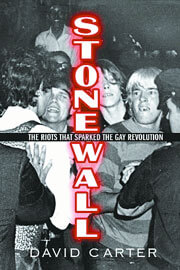We were all there, and now let’s go home already
Nonetheless, David Carter’s then hypothetical reconstruction of the evidence concerning the tortuous, mutually antagonistic relations—read turf squabble—between the Sixth Precinct and the Public Morals unit regarding that gold mine of graft, the Stonewall—touched on in “Stonewall, The Riots That Sparked the Gay Revolution”—have greatly assisted me in my own ongoing researches into the Life we all once led.
The fall of the Bastille (July 14, 1789) had very little to do with the invention of the French Revolution. The French Revolution as such was invented in and by the Reign of Terror (dates of duration and high points as recorded in the Revolutionary Calendar available on request).
The Stonewall riots represent the fall of the Bastille of the now-lionized Gay Revolution. “Stonewall, The Riots That Sparked the Gay Revolution,” is the most thoroughly researched, most coherent deuterocanonical account anybody is ever likely to read, and, like the Exodus story of the parting of the Red Sea (the one by God and Moses, not the one by Leon Uris—and this is important because David Carter is a much better writer than Leon Uris, and in fact writes very much like, well, not God perhaps, but Moses certainly), ought to be in the library of every literate queer who likes an argument.
And if of necessity “Stonewall” preaches, it doesn’t really preach to the choir so much as give the choir a singing lesson, and God knows those ones need the discipline as they’ve been singing off-pitch, sharping more than flatting for at least a decade. (And let’s get this straight: nobody is talking here about The Gay Men’s Chorus; The Gay Men’s Chorus sings better than even the Mormons.)
I am writing this in Dublin, which, having just finished celebrating (most exuberantly) the one hundredth anniversary of Bloomsday, is gearing up for a week-long celebration of gay pride, for which a brochure has been printed, complete with grand picture and lovely words of congratulation and encouragement by the lord mayor, a darling-looking family man, not gay as such, but of wide sympathy, and quite on the qui vive (in this at least), politically speaking. And all because of Stonewall? So it says in Carter’s book, and not in small print either.
I mention this because in my bold youth (and please, don’t worry, I still, unlike the great majority of well-to-do homosexuals I have met in my travels in gay America, vote Democratic) I was described as temperamentally resembling a Fenian, and indeed in one way a more apposite comparison, mentally and spiritually, to Stonewall-veteran faggotry could scarcely be imagined. The Fenians were and are the wild boys, the scare queens, of the movement of Irish liberation from seven centuries of English rule. They called themselves Sinn Fein—“Ourselves Alone”—and today having laid down their arms, they are represented in the Irish Parliament (whereas nobody remotely Jacobin has sat in the French National Assembly since the founding of the Third Republic).
I mention this in attempt to suggest that just as any and every Irish American who wished to further himself in his new country had absolutely to accommodate both his exuberance and his Celtic Otherworld dimension—well, look at the Kennedys—(illustrating both the ineluctable modality of the visible and the Queer Land-of-Oz dimension, as well as to stressing plain fact) no queer with any kind of Stonewall notion of going naked into battle, as did the Celts, men and women both, scaring the shit out of the Romans, is ever going to go to Washington, except as Mr. Smith’s Back Street trick, okay?
And to round off the argument of dimension, bringing in as I do like to do the idea of a Queer Republican Calendar (and you can take Republican in any sense you like), for an enormous number—in fact a demonstrable majority of homosexual men and women over the age of 60 (who were of course in 1969 over the age of 25, not street kids, and thus aware as David Carter has not become of the fact that New York throughout the 60s, in the wake of the Kennedys and as a result both of the markedly queer dimension to Camelot and of the relatively laissez-faire Lindsay administration, had already become if not quite queer-friendly, then certainly more queer-flexible –and this in spite of the transparently opportunistic and largely ineffective gestures of Ilse Koch, she-wolf of the SS, and the bumbling Carol Greitzer) “Stonewall” all told happened not late in the month of June, 1969, but at the end of the month of Judy in the year of The Man That Got Away.
This necessary canonical idea, at the time as self-evident as the propositions in the Declaration of Independence, was unhappily, almost immediately suppressed—for Judy had died ingloriously, and her cause would not be revived until a generation of her adherents had died looking more or less the way she did—by the Directoire of the movement, sponsors of the Reign of Terror of the Clones (and their color-coded handkerchiefs).
But to the situation of the book—and I must tell you sadly that David Carter doesn’t buy the Judy effect either—you must go out and buy it. Its architecture is sturdy and its detail engrossing. The main characters (all naturally self-appointed, self-serving, self-involved, and so what?) are incisively drawn and extremely well-cast, and if one is inclined to say at the end “Oh, yeah? Well, that’s your story, sisters, and yez are all stuck with it,” then the onus of a sceptic’s collected reservations falls not on David Carter, who has spun a great yarn, but on the fabricators of the yarn itself, which really is not only not strong silk, or better still nylon, but more like the polyester of the double-knit suits in sorbet shades so popular in the 70s or even, I’m afraid, Ultrasuede.
Here then, in David Carter’s strong telling, was a situation pregnant with possibilities in which not only did nobody think to say “Everybody go home” (the way I had by 11:45), but suddenly Everybody Who Should Have Been There seems to have in fact descended on the dump like it was Bloomingdale’s going out of business or the appointed site of the Second Coming of Maria Montez. One must only marvel at the miraculous Foundation Myth glory of it all, as so many of the select elect would seem to have been endowed with that property of the glorified body (as defined, of course, before the era of the serious gym-clone) known as bi-localism.
And mystery more, the non-response of the gallant Sixth Precinct, while the Public Morals (after what used to be called, but seems to be no more called, the “shot glass heard `round the world”) ducked down behind the bar, and finally became barricaded inside the place like obdurate revellers blitzed at the Ritz, which however The Stonewall surely wasn’t.
It was of course Max’s Kansas City, where the real work of revolution was being accomplished night after night throughout the late 60s and early 70s, that was more—in fact the most, in terms of who came and did what—like The Ritz. Another story for another book review—and in fact both the book and the review have been out since the late 90s, and would not be mentioned here at all but for the irresistible opportunity afforded by David Carter’s citation of three Stonewall drag queens meant to be emblematic of the allure of the events that transpired there: Jackie Hormona, Marsha Johnson, and Zazu Nova. I mean, pleased to meet you, girls, but really, as over and against Jackie Curtis, Candy Darling and the supreme and evergreen Miss Holly Woodlawn, not only no cigar, sweethearts, but no match either to light up your last roach, get me? Time for you all to check in your lips and go home.
We also publish:


































